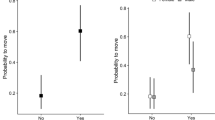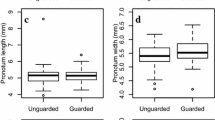Abstract
Mate guarding is predicted to be one of the driving forces for the evolution of monogamy, but supporting evidence in free-living mammals is rare. The goals of our study were three-pronged. First, we tested if mate guarding, measured as intrapair distance, occurs as a behavioral tactic in round-eared sengis (Macroscelides proboscideus), a socially monogamous species lacking paternal care and in which females breed asynchronously, producing 2–3 litters during an 8-month long breeding season. Second, we determined if mate guarding involves costs which we identified as changes in male body mass. Third, we investigated whether variation in individual investment in mate guarding depended on the males’ body mass and the number of neighboring males. Field data were collected in a semidesert in South Africa using radio-tracking, trapping, and direct observations during three successive breeding seasons. Mate guarding strongly depended on the females’ reproductive state, and all males started to guard their mates prior to and during estrus, as exemplified by reduced intrapair distance. Mate guarding incurred costs: overall, males lost about 5% of body mass. Male body mass loss and initial body mass were negatively related to the intensity of precopulatory mate guarding. Furthermore, during estrus intrapair distance was inversely correlated with the number of neighboring males. The results show that mate guarding is the predominant male tactic in round-eared sengis. However, since mate guarding imposed costs, males may balance benefits and costs associated with guarding by varying their effort in relation to their physical capabilities and the competitive environment.



Similar content being viewed by others
References
Alberts SC, Altmann J, Wilson ML (1996) Mate guarding constrains foraging activity of male baboons. Anim Behav 51:1269–1277
Bates D (2005) Fitting linear mixed models in R. R News 5:27–39
Brotherton PNM, Komers PE (2003) Mate guarding and the evolution of social monogamy in mammals. In: Reichard UH, Boesch C (eds) Monogamy: mating strategies and partnerships in birds, humans and other mammals. Cambridge University Press, Cambridge, pp 42–58
Clinton WL, LeBoeuf BJ (1993) Sexual selection’s effects on male life history and the pattern of male mortality. Ecology 74:1884–1892
Corbet GB, Hanks J (1968) A revision of the elephant-shrews, Family Macroscelididae. Bull Br Mus (Nat Hist) Zool 16:1–111
Cowling RM, Esler KJ, Rundel PW (1999) Namaqualand, South Africa—an overview of a unique winter–rainfall desert ecosystem. Plant Ecol 142:3–21
Currie D, Valkama J (2000) Population density and the intensity of paternity assurance behavior in a monogamous wader: the Curlew Numenius arquata. Ibis 142:372–381
Dick JTA, Elwood RW (1996) Effects of natural variation in sex ratio and habitat structure on mate-guarding decisions in amphipods (Crustacea). Behavior 133:985–996
Dixson AF (1983) The hormonal control of sexual behavior in primates. In: Finn CA (ed) Reviews of reproductive biology. Clarendon Press, Oxford, pp 131–219
Faraway JJ (2006) Extending the linear model with R. Generalized linear, mixed effects, and nonparametric regression models. Chapman and Hall/CRC Press Company, New York
Festa-Bianchet M, Jorgenson JT, King WJ, Smith KG, Wishart WD (1996) The development of sexual dimorphism, seasonal, and lifetime mass changes in bighorn sheep. Can J Zool 74:330–334
FitzGibbon CD (1995) Comparative ecology of two elephant-shrew species in a Kenyan coastal forest. Mamm Rev 25:19–30
FitzGibbon CD (1997) The adaptive significance of monogamy in the golden-rumped elephant-shrew. J Zool Lond 242:167–177
Gowaty PA, Plissner JH (1987) Association of male and female American robbins (Turdus migratorius) during the breeding season: paternity assurance by sexual access or mate-guarding. Wilson Bull 99:56–62
Grafen A, Ridley M (1983) A model of mate guarding. J Theor Biol 102:549–567
Huck MA, Lottker P, Heymann EW (2004) Proximate mechanisms of reproductive monopolization in male moustached tamarins (Saguinus mystax). Am J Primatol 64:39–56
Iribarne O, Fernandez M, Armstrong D (1995) Precopulatory guarding time of the male amphipod Eogammarus oclairi: effects of population structure. Mar Biol 124:219–223
Jirokul M (1999) Population density influences male-male competition in guppies. Anim Behav 58:1169–1175
Jivoff P (2003) A review of male mate guarding success in the blue crab, Callinectes sapidus, in reference to the potential for fisheries-induced sperm limitation. Bull Mar Sci 72:273–286
Kleiman DG (1981) Correlations among life history characteristics of mammalian species exhibiting two extreme forms of monogamy. In: Alexander RD, Tinkle DW (eds) Natural selection and social behavior. Chiron Press, New York, pp 332–344
Komdeur J (2001) Mate guarding in the Seychelles warbler is energetically costly and adjusted to paternity risks. Proc R Soc Lond B Biol Sci 266:2075–2081
Komers PE, Messier F, Gates CC (1994) Plasticity of reproductive behavior in wood bison bulls: on risks and opportunities. Ethol Ecol Evol 6:485–495
Lifjeld JT, Dunn PO, Robertson RJ, Boag PT (1993) Extra-pair paternity in monogamous tree swallows. Anim Behav 45:213–229
Lovegrove BG, Laws MJ, Roxburgh L (1999) Confirmation of pleisiomorphic daily torpor in mammals: the round-eared elephant shrew, Macroscelides proboscideus (Macroscelidea). J Comp Physiol 169:453–460
Manno TG, Dobson FS (2008) Why are male Columbian ground squirrels territorial? Ethology 114:1049–1060
Manno TG, Nesterova AP, Debarbieri LM, Kennedy SE, Wright KS, Dobson FS (2007) Why do male Columbian ground squirrels give a mating call? Anim Behav 74:1319–1327
Matthews LM (2002) Tests of the mate guarding hypothesis for social monogamy: does population density, sex ratio, or female synchrony affect behavior of male snapping shrimp (Alpheus angulatus)? Behav Ecol Sociobiol 51:426–432
Møller AP, Birkhead TR (1989) Copulation behavior in mammals: evidence that sperm competition is widespread. Biol J Linn Soc 38:119–131
Møller AP, Birkhead TR (1991) Frequent copulations and mate guarding as alternative paternity guards in birds: a comparative study. Behavior 118:170–186
Monclús R, Rödel HG, von Holst D, de Miguel J (2005) Behavioural and physiological responses of naïve rabbits to predator odour. Anim Behav 70:753–761
Munshi-South J (2007) Extra-pair paternity and the evolution of testis size in a behaviourally monogamous mammal, the large treeshrew (Tupaia tana). Behav Ecol Sociobiol 62:201–212
Parker GA (1974) Courtship persistence and female-guarding as male investment strategy. Behavior 48:157–184
Poole JH (1989) Announcing intent: the aggressive state of musth in African elephants. Anim Behav 37:140–152
R Development Core Team (2008) A language and environment for statistical computing. R Foundation for Statistical Computing, Austria: Vienna, ISBN 3-900051-07-0, URL http://www.R-project.org
Rathbun GB (1979) The social structure and ecology of elephant-shrews. Adv Ethol 20:1–79
Ribble DO, Perrin MR (2005) Social organization of the eastern rock elephant-shrew (Elephantulus myurus): the evidence for mate guarding. Belg J Zool 135:167–173
Sauer EGF (1973) Zum Sozialverhalten der kurzohrigen Elefantenspitzmaus, Macroscelides proboscideus. Z Säugetierkd 38:65–97
Sauer EGF, Sauer EM (1971) Die kurzohrige Elefantenspitzmaus in der Namib. Namib and Meer 2:5–43
Schubert M, Pillay N, Ribble DO, Schradin C (2009) The round-eared sengi and the evolution of social monogamy: environmental parameters constrain males to live with a single female. Ethology (in press)
Schwartz AM, Baird TA, Timanus DK (2007) Influence of age and prior experience on territorial behavior and the costs of defense in male collared lizards. Ethology 113:9–17
Setchell JM, Charpentier M, Wickings EJ (2005) Mate guarding and paternity in mandrills: factors influencing alpha male monopoly. Anim Behav 70:1105–1120
Skinner JD, Smithers RHN (1990) The mammals of Southern Africa subregion, 2nd edn. University of Pretoria Press, Pretoria
Stearns SC (1992) The evolution of life histories. Oxford University Press, Oxford
Stockley P (1997) Sexual conflict resulting from adaptions to sperm competition. Trends Ecol Evol 12:154–159
Storey AE, French RJ, Payne R (1995) Sperm competition and mate guarding in meadow voles (Microtus pennsylvanicus). Ethology 101:265–279
Trivers RL (1972) Parental investment and sexual selection. In: Campbell B (ed) Sexual selection and the descent of man. Aldine Press, Chicago, pp 136–179
van Dongen WFD (2008) Mate guarding and territorial aggression vary with breeding synchrony in golden whistlers (Pachycephala pectoralis). Naturwissenschaften 95:537–545
van Rhijn JG (1991) Mate guarding as a key factor in the evolution of parental care in birds. Anim Behav 41:963–970
von Holst D (1998) The concept of stress and its relevance for animal behavior. Adv Study Behav 27:1–131
Yamamura N (1987) A model on correlation between precopulatory guarding and short receptivity to copulation. J Theor Biol 127:171–180
Acknowledgments
We are grateful to the Department of Tourism, Environment, and Conservation of the Northern Cape, South Africa and the staff at the Goegap Nature Reserve for their assistance. We thank D. von Holst, T. G. Manno, and one anonymous referee for constructive comments and suggestions on the manuscript. The animal ethics clearance numbers were 2003/76/03 and 2006/06/03, and certificated by the Animal Ethics Screening Committee of the University of the Witwatersrand. The clearance numbers for live trapping, handling, radio-tracking, and observing round-eared sengis at the Goegap Nature Reserve were 0902/04, 0888/05, 0175/06, and 0890/06. We thank the National Geographic Society for the financial support. One of the authors, M. Schubert, was supported by grants from the German Academic Exchange Service (DAAD), the FAZIT-Stiftung, and the Ethologische Gesellschaft e. V.
Author information
Authors and Affiliations
Corresponding author
Additional information
Communicated by A. Schulte-Hostedde
Rights and permissions
About this article
Cite this article
Schubert, M., Schradin, C., Rödel, H.G. et al. Male mate guarding in a socially monogamous mammal, the round-eared sengi: on costs and trade-offs. Behav Ecol Sociobiol 64, 257–264 (2009). https://doi.org/10.1007/s00265-009-0842-2
Received:
Revised:
Accepted:
Published:
Issue Date:
DOI: https://doi.org/10.1007/s00265-009-0842-2




